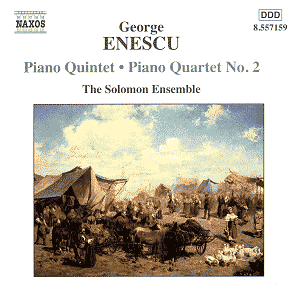George
Enescuís name is well known for having been Yehudi Menuhinís teacher
and the composer of Roumanian Rhapsody No.1, but the rest of his
output is little known. This disc is to be welcomed to help redress
the balance.
Considering
that he died as recently as 1955 it is interesting that two of
my books give different places of birth in Roumania for him and
the CD insert simply says he was born in Moldavia, which presumably
refers to the easternmost province of Roumania that borders on
present-day Moldova. Neither do they all agree with the year or
day of birth, though most generally agree with a day in August
1881.
However,
what they all agree on is that Enescu was an outstanding musician
in every sense - a superb violinist and competent pianist, whose
ability to play all of Wagner at the keyboard from memory,
is one of those jaw-dropping facts that I always find helps
me to listen in a different way to the work under review. Menuhin
tells of Enescu being able to play Ravelís new violin sonata from
memory after only two brief readings with the composer. His phenomenal
memory enabled him to hold the complete works of Bach there,
which sounds so utterly fantastic when one considers how many
hours it would take just to listen to them all!
A
violin pupil of Vieuxtemps and of composition with Massenet and
Fauré, Enescu was a true child prodigy who had a concert
of his music performed in Paris at the age of 16. By the time
he was 18 when he won first violin prize at the Paris Conservatoire,
he was already known as a composer, his "Poème Roumaine"
having proved especially successful. However, though he wanted
so much to be known as a composer rather than purely a recitalist
his work found success only among a small handful of admirers
and fellow composers. In all he wrote relatively few works and
barely more than a dozen after World War I.
The
liner notes say that "Enescuís mature work is of a density
of thought and subtlety of expression to demand repeated listening".
I found I had to listen to the Piano Quintet many times
before it began to grow on me. Even the principal themes are understated
to such an extent that it took a long time to identify them, even
though I had recognised them subconsciously. Also reading and
re-reading the liner notes, I began to wonder if we were listening
to the same piece as, after discussing the first movement, they
talk about "the succeeding Vivace ma non troppo" movement
as if it were the 2nd whereas it is the third and final
movement, there being no mention of the second movement at all.
In fact the second movement is a perfect example of what the liner
note writer describes as Enescuís way of composing in which "his
themes, while rarely drawing attention to themselves, are capable
of far-reaching transformations both across and between movements".
I find such music difficult to listen to, not because the music
itself is over-complex but I like themes that leap out and grab
me, that pull me into the work. I remember, as a child telling
my mother that I did not like chamber music and she explained
that it was an acquired taste that came with time. She was right
of course and I now find it more emotionally stimulating than
any other genre, but, nevertheless I respond best to strong themes
like those in Miklos Rózsaís String quartet, Op.22 (1950)
whose second movement is a captivating "Scherzo in modo Ongarese",
or the gypsy-inspired themes in Ravelís work. I found it hard
to identify the folk influences in these works of Enescu. They
are said to be there but I cannot detect them.
The
Piano Quintet was, unfortunately, never performed in Enescuís
lifetime, a fact that I always find extremely sad. It was not
performed until 1964 in Bucharest.
Composed
between July 1943 and May 1944, the Piano Quartet No. 2 received
its premiere in Washington D.C. on 31st October, 1947,
thanks to Elizabeth Sprague Coolidge, the indefatigable champion
of chamber music in the first half of the 20th. Century.
It is a work that requires repeated listening though it reveals
itself more readily than the Piano Quintet does. It is a more
immediately accessible work though Richard Whitehouse, in the
liner notes calls it "the most searching of Enescuís mature
pieces". It was written in memory of Fauré and marked
the twentieth anniversary of his death.
The
themes are subtle and understated as before but are more easily
identifiable, and the Roumanian folk roots are clearer to hear
that in the quintet, witness track 4, 8 minutes into the first
movement just at its conclusion and picked up again immediately
the second movements begins. The final movement breaks the lyrical
quality and brings the work to a close with a powerfully stated
theme. Once again this is a work that requires a lot of listening
to reveal its layers of distilled themes. They elude the listener
during the first few hearings.
The
Solomon Ensemble is a clearly committed advocate of this music
and that makes for powerfully felt performances. They are a group
I look forward to hearing again, perhaps in works I am more familiar
with.
Steve
Arloff
see also review by Hubert
Culot and Kevin
Sutton
